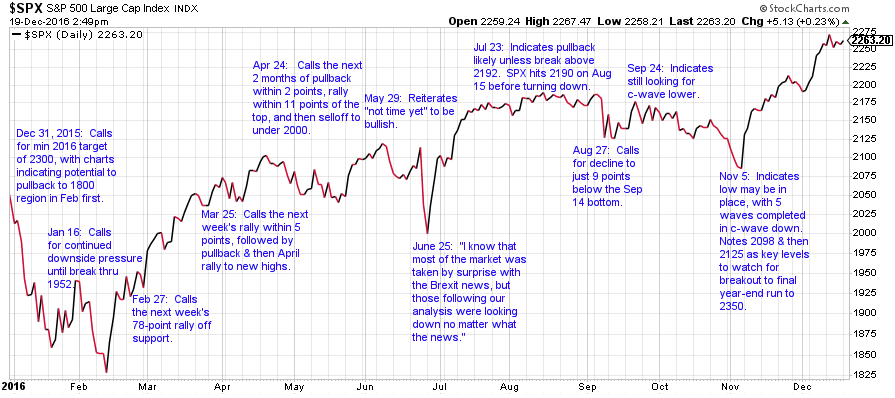Nothing Can Stop This Market - Except?
The SPX has continued its rally towards the ideal 2410SPX region this past week that we presented to you a month ago. And, it seems we still have a few squiggles to the upside left before this pattern is completed, and then tested.
Those with a short bias in this market have not fared very well. At each and every twist and turn, the market has proved its bullish intent, and continues to confirm our expectations that our long-term target of 2537-2611SPX will be met, if not even possibly exceed by next year.
In fact, I have warned for quite some time that we will begin to see former bears turning quite bullish, and we have seen this occur over the last several months. While I still do not believe we have reached the euphoric levels needed to mark a significant top, many former bears are coming over to the dark side.
In fact, I read a comment to an article this past week which sums up most people's feelings about the stock market:
"At this point, someone could drop a nuke and the markets would barely flinch."
But, I have addressed this issue many times before. You see, when the market sentiment remains in an uptrend, whatever news is thrown at the market means nothing, until the market completes its pattern. That is exactly what is occurring right now, and explains the frustration represented in the quote above. And, for those of us who really understand how the market moves, this makes all the sense in the world. For us, there have been no surprises.
Up until recently, I have not been able to provide guidance with regard to specific timing in the market. Rather, our analysis is based upon price. So, while we have identified price turns and targets quite effectively and accurately through the years, I have not found any timing cycles which have provided more than 50% accuracy. Well, until now.
Other than traders of metals, some of the most emotional and angry traders/investors I have seen in the "blog-o-sphere" are those who solely follow timing cycles. While there are many different cycles people follow, most seem to confound those who attempt to trade them.
While there may be certain segments of time that seem to work, they often leave people scratching their heads when the market changes cycles without warning. Well, markets don't warn when they change their timing, do they? And, in fact, I have seen cycles analysts blow up many of their followers' accounts.
Now, as I went through my own search of analysis methodologies early in my investment career, I always attempted to maintain an open mind and heavily contemplated any methodology which seemed to have a following. And, clearly, timing cycles have a strong following. But, intellectual honesty in the market is what will maintain your account on the correct side of the market, and anything that is unable to pass the test of intellectual honesty should be viewed quite skeptically.
Along those lines, when I contemplated these timing cycles, I had an open question which no timing cycles analyst was ever able to answer:
"If markets are non-linear in nature, how can a finite, linear timing window accurately prognosticate the market more than 50% of the time?"
You see, when you assume price and time are linear, you're overlooking the clear nonlinear nature of price movement. Traditional cycle analysis assumes linear and angular movement of price through time. But, if you understand that sentiment drives asset prices and is non-linear in nature, then does it make sense that the timing of sentiment is linear?
Do the ebbs and flows of human emotion track neatly like the hands of a clock? Of course not. Humans' fears and greed are not set to sixty second and sixty minute increments any more so than rainstorms.
So, there must be a tool available that can see around linear corners of time. There must be a tool that quantifies human subjectivity as crisply as it analyzes data. I would argue such a tool has existed for over 100 years and is presently used in all areas of science and forecasting. That tool is Bayesian analysis and its specialty is decision making with nonlinear data in an uncertain world.
So how does the application of Bayesian analysis improve investment timing decisions? Bayesian is, at its best, working with nonlinear data and "learning" the underlying process of the variable of interest.
In the context of this discussion, Bayesian is learning the timing cycles of asset price movement by studying information found in option prices. Options contain many valuable pieces of information; however, the most valuable are the embedded sentiments and beliefs of price and time expectations of market participants. Thus, the Bayesian timing approach probabilistically quantifies turning points in time for security prices by using conditional information found in option prices. The end result is a powerful tool to help answer the question "When should I take a security position?" Combining this methodology with one that is able to track the sentiment affects upon price leads to potent 1-2 punch for traders.
To this end, for quite some time, I have been watching the work of Luke Miller. I met him when he became a member of my Trading Room at Elliottwavetrader.net well over a year ago. I have been quite impressed with his work, as I am sure you will be as well, along with his impressive credentials.
Luke has been an active trader for over twenty years and got into swing trading to finance his undergraduate and masters degrees in industrial & systems engineering and a PhD in financial engineering. In 2003, Luke earned the Gilbreth Memorial Fellowship (top PhD student in the nation) and has since published over one dozen peer reviewed journal articles and a book in his area of expertise - investment timing decisions utilizing a novel technique he developed called Bayesian Learning Option Pricing (BLOP).
Luke's Bayesian timing research has been presented all over the world and most recently won Best Presentation Award at the 18th International Conference on Business & Finance in Paris in 2016. Luke is presently a college professor and investment consultant to high net worth clients; using his Bayesian timing system to earn 30% per annum since 2007 by trading ETFs in indices, energy, and metals.
Luke will begin writing some articles with me about his Bayesian timing methodology, so I wanted to offer an introduction to his work this week. Be on the lookout for further articles explaining Luke's groundbreaking work on timing, which complements the sentiment analysis we provide.
Since 2015, the market has been providing us with an almost textbook pattern to follow, and has led us quite well to maintaining on the proper side of the market through its twists and turns.
Of late, when we called for a market pullback/consolidation on March 1, the market has complied quite well, and provided us with what I have primarily counted as an a-wave to a wave (iv), which struck its target at the .236 retracement of wave (III).
Moreover, when we called for 2330SPX to hold a month ago and set up a rally to 2410SPX, that too followed the textbook patterns we have been following.
But, now the market has a decision to make. You see, my primary expectation is for the market to now provide us a c-wave drop in the coming weeks to complete a larger degree wave (iv). The resistance for this potential is the 2410-2425SPX region. And, as long as we remain below that resistance, then I am looking for a drop to at least the 2330SPX region, but, more preferably down to the 2285SPX region to complete wave (iv). An impulsive break down below 2381SPX is a strong signal that the c-wave is in progress.
However, if the market is able to break out through resistance before providing us our c-wave down, then it suggests it will be taking the more direct route to the 2500SPX region to complete wave (V) of (3) a lot sooner than I had expected.
And, as I have noted so many times in my trading room at Elliottwavetrader.net, please do not forget that this is a bull market, and it must be respected as such. For this reason, I am not suggesting anyone aggressively trade for a c-wave down. Rather, any c-wave down should be used as an opportunity to add to your long positions.


















